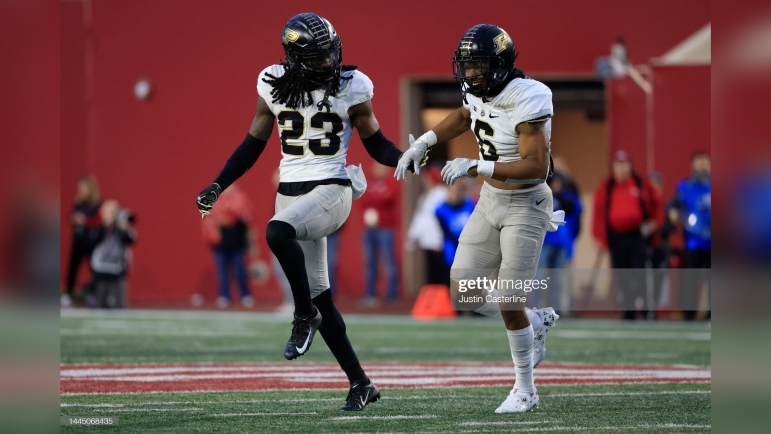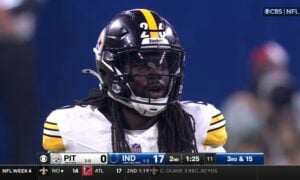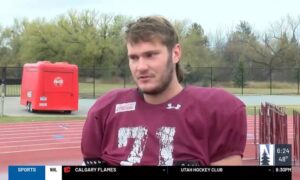Ahead of the 2023 NFL Draft, myself, among others, were of the belief that Pittsburgh would be best served to double dip at the cornerback position, addressing needs both on the boundary and in the slot. Ultimately, they decided to double dip at the position, although going in a different direction, adding a pair of long-limbed, physical cornerbacks, potentially adding multiple building blocks at the boundary cornerback spot.
While I still have questions about the viability of their current options in the slot, it’s hard to fault their strategy in addressing the position, securing the rights to not one, but two players who were projected to go much higher. Much of the commentary post draft has centered around the theme of valuing length, physicality, and press coverage ability at the position.
Nonetheless, despite my valuing Cory Trice Jr. much higher than his seventh-round selection, I find it important to acknowledge that he is by no means on the level of Joey Porter Jr, and has struggles, even beyond obvious medical red flags, that caused him to fall in the draft. Notably, when diving deeper into Trice’s Purdue tape, it is clear that he lacks both the eye discipline and game speed of Porter. As he tends to favor playing from the low shoulder more than Porter, he is far more susceptible to allowing deep balls and explosive plays downfield. Likewise, where he is an equally physical tackler at the catch point, Trice’s effort when tasked with defeating blocks on the perimeter is inconsistent at best.
Whereas he may lack the discipline and consistency of Porter in coverage, Trice’s natural feel in zone coverage and ball skills to bait routes and generate takeaways are already at a higher level than his new teammate. All that being said, in a seventh-round selection, betting on extremely high-level traits in a prospect is never a bad idea, particularly having drafted a more NFL ready prospect earlier at the same position. Moreover, both players having the chance to enter a room with great veteran mentorship from Patrick Peterson and Levi Wallace, as well as a perennial All-Pro safety in Minkah Fitzpatrick, should bode well for their early career development.
The subject of today’s article is Cory Trice’s ability in man coverage. It is important to note that due to a lack of available coach’s tape from his Purdue career, we will mainly be evaluating TV tape. In that respect, much of my analysis was limited to plays where he was targeted and may lack context in the mid-phase of the route.
We’ll start with a pair of late targets from the Boilermakers’ matchup at Syracuse this past season, where Trice found himself heavily targeted on the final drive of a one-possession game at the Carrier Dome. Here, working in an isolated press man coverage matchup in the boundary, Trice attempts a two-hand jump jam, getting caught flat footed but landing his inside hand and forcing a wide release.
From there, he is able to close and squeeze from the top shoulder, staying in phase to play the hands at the catch point and break up the back-shoulder pass despite a well-thrown ball. While he certainly needs to clean up his footwork at the line and play with more patience, he is consistently able to land his punch. As a result, he can routinely force wide releases in press coverage.
Later in the same drive, working in an isolated press coverage matchup in the boundary, Trice is caught with his feet flat at the snap, false stepping a bit while attempting to engage a two-handed jump jam. He is able to recover quickly and close to the upfield shoulder.
At the top of the route, Trice has effectively squeezed to get chest to chest with the receiver, eliminating any airspace for a back shoulder ball and putting himself in position to turn into the receiver and bat the pass away with his off arm. Much like we saw in the Porter film room, corners will routinely get away with physicality at the top of routes if they squeeze to get chest to chest and eliminate airspace from the top shoulder. Larger-framed corners, like Trice and Porter, are able to maximize their advantages and length and strength from this top shoulder position.
One of the most important aspects of press coverage is being able to effectively align and protect your leverage. Trice’s length allows him to overcome a lack of patience and effectively seal off inside releases on slant routes. Here, aligned with inside leverage in press coverage, Trice stays square at the snap before firing a physical two-hand jam into the receiver’s top shoulder, flattening the route and buying himself time to close to the catch point.
Staying in phase with a subtle grab on the back of the receiver’s jersey, Trice plays the catch point with great physicality, punching through the pocket and finishing the rep through the ground to ensure the pass breakup. While he is not the most technically refined corner at the moment, his powerful punch in the release phase and catch point physicality are great tools for the Steelers’ coaching staff to work with, starting in rookie minicamp.
In off-man coverage, despite limited reps, Trice has shown refined footwork and great ability to stay square and drive routes from a backpedal. While his eye discipline remains inconsistent, reps like this show how great Trice can be when he remains technically sound on an off-man coverage rep.
At the snap, Trice is 3×6 with outside leverage on the cut split receiver, aligning in a side shuffle before pushing off his inside foot and transitioning into a backpedal, patiently giving ground while staying square with his eyes glued to the receiver’s hip. As the receiver breaks toward the sideline, Trice smoothly plants his back foot and breaks downhill, driving the upfield shoulder and punching up through the pocket to force the incomplete pass. Just a textbook off-man coverage rep here from Trice, particularly impressive as he rarely played from a pedal at Purdue.
In general, putting Trice in off-man coverage, something the Boilermakers rarely did, whether due to scheme or his own preference, is something I would like to see done more at the next level. While his powerful strike and lengthy frame allow him to bully receivers in the release phase from press, his footwork in off-coverage is far more patient and he is forced to play from the upfield shoulder, naturally protecting against the deep ball.
Here, against Minnesota, Trice aligns 8×1 with inside leverage in the red zone, working from more of a flat-foot read. He has no room to give ground without pedaling into the end zone, a cardinal sin of defensive back play. As the receiver declares for the pylon on the fade route, Trice squeezes to the upfield shoulder, turning into the receiver to locate the football. He uses his length to blanket the catch point, nearly plucking an impressive pick off the receiver’s helmet. Again, for as much attention that will be given to Trice’s ability to thrive in press-man coverage, his off-man ability impresses me equally, if not more, and is a trait to continue relying on more heavily at the next level.
Where Trice gets into trouble is when he finds himself unable to land his punch at the line and is forced to quickly change direction and match receivers in space without relying on physicality. Here, aligned in press coverage, Trice kick-steps to match a wide release, but the receiver does a good job of staying low and protecting his chest, preventing Trice from squeezing to the top shoulder.
Finding himself even with the receiver at the top of the route and playing with high pad level, Trice is at the receiver’s mercy, finding his feet stuck in the mud and allowing tangible separation on the comeback route. Even more disheartening, rather than closing from out of phase with proper eye discipline, Trice is caught eying the quarterback from out of phase, ultimately allowing an uncontested catch and unnecessary yards after the catch. Reps like this show how Trice will need to continue developing his patience and footwork in coverage, with overreliance on a dominant punch unlikely to cut it against crafty NFL route runners.
Overall, Cory Trice Jr. possesses a strong skill set well worthy of his seventh-round selection. His combination of size, physicality, and ball skills is unique for the position and makes him an ideal developmental player at the position. That being said, using similarities in size and physicality to compare the skill sets of Trice and Porter is inaccurate and does a disservice to the Penn State product. Where both prospects have room to improve, Porter’s rep to rep consistency and ability to eliminate explosive plays in the passing game is among the best in this year’s class.
While possessing neither the current refined skills nor top-end ceiling of Porter, I strongly believe that Trice has a chance to develop into a solid sub-package player down the line. His raw size and physicality make me wonder whether he could potentially move inside and match tight ends in certain sub-package looks. Likewise, while I believe that he has the tools to excel at the cornerback position down the line, his tackling ability makes a move to safety, and potentially, dime backer, an intriguing possibility.
Through his potential matchup versatility and theoretical special teams value, where he can immediately challenge James Pierre as a gunner, which should open a window for him to make an impact in year one. Regardless, it is abundantly clear that Trice has the developmental skills to become a capable, and potentially, impactful NFL player down the line. And one who’s best football may still be yet to come.








